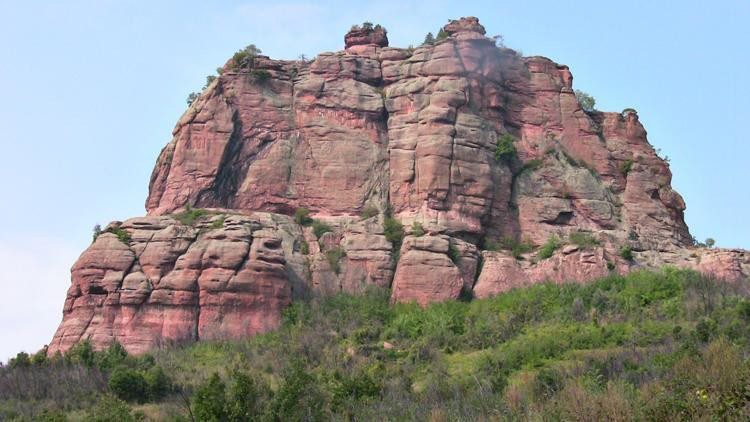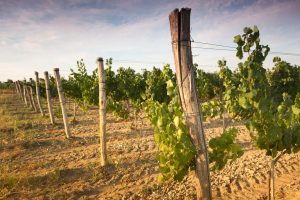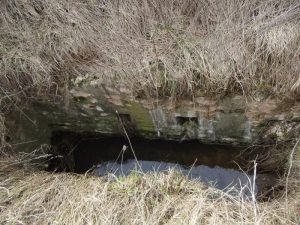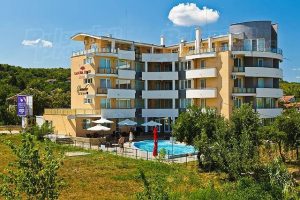

Pine Stone, known as “Borovitza stone” or “Borovitza Scale” is a majestic stone monument with an aesthetic value, located on north of Borovitsa, Vidin district (43.59074, 22.73084). It is part of an ensemble of rocks and is built of mainland red sandstone, formed about 220 million ago. It was declared a natural monument in 1976.
Pine Stone is located in the structural area of Western Balkans and is in the shape of rocks formed by conglomerates and sandstone, which is part of the terrigenous group Petrohanski of of lower Triassic distributed widely in the Western Balkans. It is disclosed in Belogradchik and is made up of polygenic, valunni rocks and consists of red-violet conglomerate with well rounded pieces of 5 to 30 cm and sandstones of which quantity is increasing. The thickness of this unit is between 200 and 550 m. The lower limit is not disclosed in this region, only below the stone base of Borovitza.
It is a really great cliff formed by erosion in the past few million years. Being part of the Belogradchik rocks, Pine Stone is distinguished by its impressive dimensions – height 113 m, length 180 m and a width of about 120 m. The scale is divided into two, and the east is larger both in size and in height. The west is slightly smaller and has a sharp ridge.
The name is very old and comes from the pines from the ridge which obviously have decorate the place in antiquity. From there also comes the name of the Borovitsa village. Unfortunately, in the summer of 2000, the pines were victims of a devastating fire. However, “Pine Stone” has retained its grandeur and along with the groups surrounding the rocks below, looks like a scale model of the famous “fingers” of the Monument Valley, from Utah and Arizona. These rocks are the same age as the rocks assembly impressive and very popular American. The comparison arises spontaneously and is not exaggerated. Pine Stone and the smaller groups from around the prominent rocks, is really admired by the impartial observer, and if it were green, could easily be confused with the landscape in Arizona. To the east of Pine Stone is revealed an impressive landscape, which corresponds with the beauty of a safety zone around the rocks of Belogradchik. These rock formations, without name, to the north of the road to Borovitza and Belogradchik, impress with their various forms, perhaps, and in the future will bear the name of the heroes of our time.
From the historical point of view, the area is also very interesting, although it does not have ancient castles or monasteries. At 3 km downstream of the Stakevska river is a historical place called “Falkovets” (from the Latin Falco – falcon, hawk). There was a large Roman settlement, which was prosperous, and at Falkov there was even a coal mine. Into it and to the west along river of Pine Stone is just below the rocky crown of Triassic limestone cliff there was a village that was destroyed by the Hun invasion in 441-447.
Behind the “Pine Stone” was an observation tower, which has a visual connection with the river Ratsiaria. We found also 4 horizontal round holes with a depth of 50 cm, which are supposed to be traces of an ancient bridge. Under Pine Stone was a foundry, where were found Roman coins from the second-third centuries.
The legends are not known, only a work of art from the book “Whispers of the time” called “Pine Stone” which re-creates the drama of antiquity whose protagonists are Boris and Elitsa in love, they flee from the wrath of the girl’s father, and living buried in the rock. They have replaced the pine trees with crops. According to locals, however, they are entirely fictional. Regardless of its greatness, Pine Stone is not a tourist place it remains in the shadow of Belogradchik Rocks. It is seen coming on the road to Belogradchik and is seen as part of this ensemble. The rocks are highly eroded entities that do not require special protective measures. The main problem with this type of erosion is the stopping of erosion due to afforestation and grass appearance. Here the erosion happened naturally and however paradoxical it may sound, the burning of pins on the rocks is a positive step towards the conservation of the geological formations. In essence, the rocks are buried in scrubland and low forests, which adds the beauty to the landscape, but stops further modeling of the composition of the rock.




